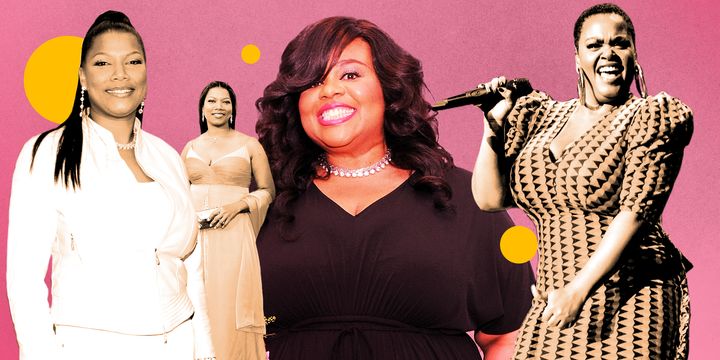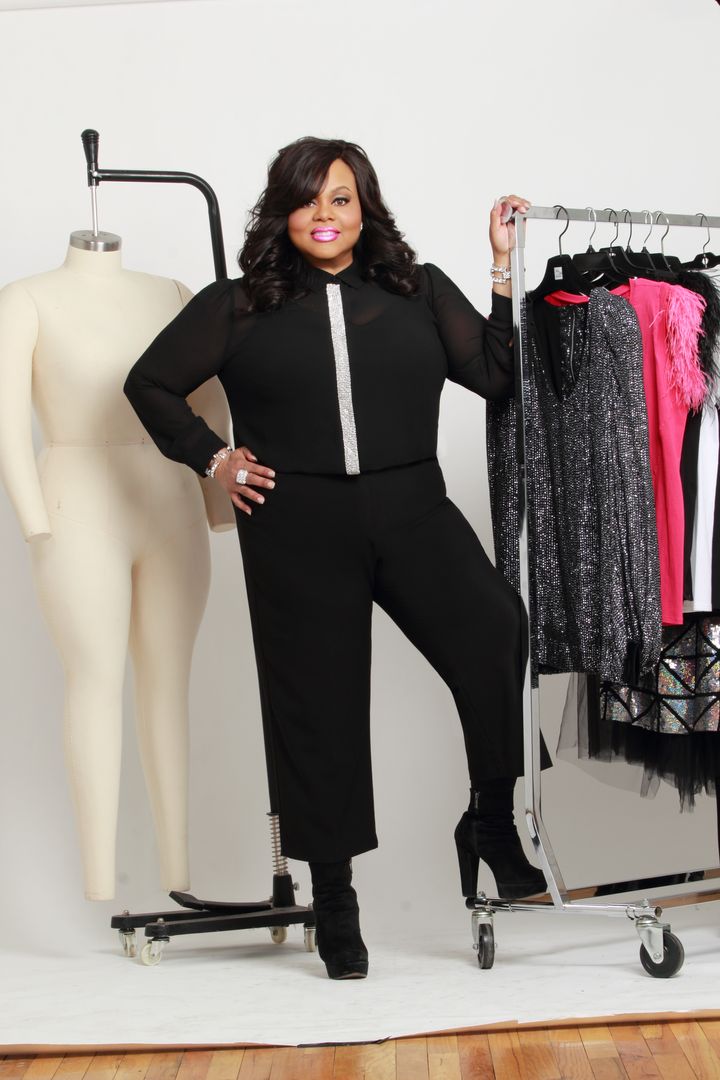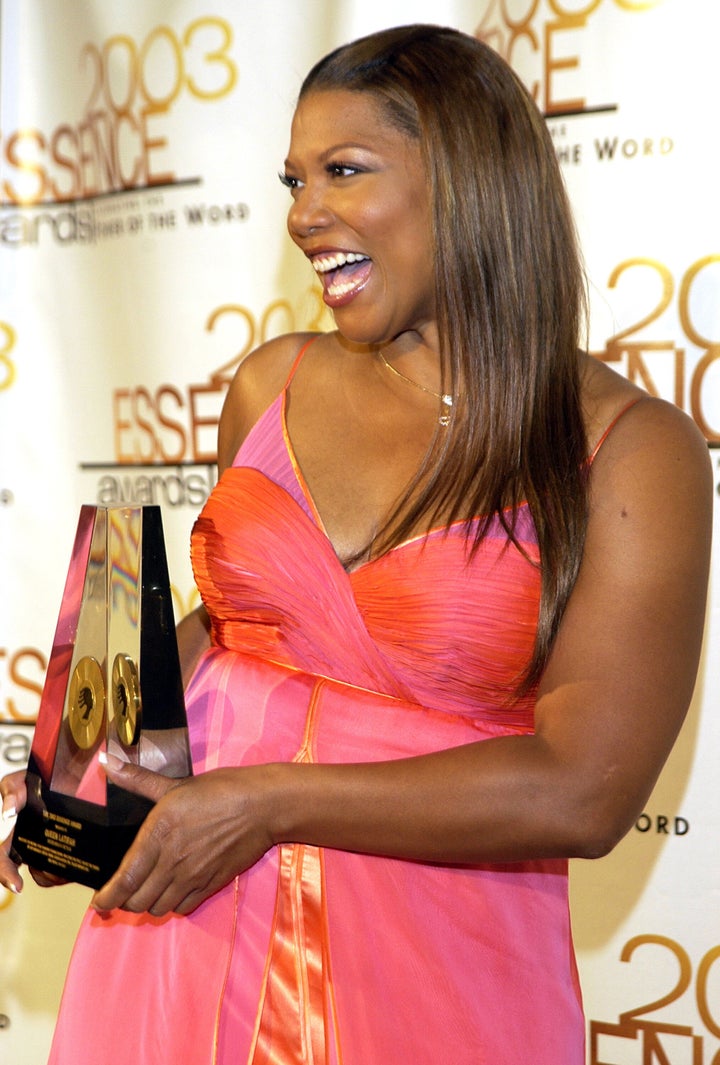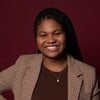
The glitz and glamour of entertainment is nothing without the people who dress today’s biggest stars. For “Who’s Behind the Clothes,” HuffPost spotlights stylists and costume designers who have delivered some of our favorite celebrities’ or characters’ most memorable looks. Read my interview with “The Woman King” costume designer Gersha Phillips.
Former stylist to R&B singer Jill Scott, actor-rapper Queen Latifah, comedian-turned-actor Mo’Nique and others, Susan Moses got her start on working on Seventh Avenue in New York City. Hailing from the South Bronx, she balanced countless retail jobs while in school at John Jay College of Criminal Justice. Moses was on track to launch a career in politics, but working with models backstage during fashion week diverted her plans.
“There was a small company that would hire dressers at the fashion shows to dress models at the different shows,” Moses recalled. “I had a semester and a half left. I’m sitting there taking a test, and I looked around the room and I was like, ‘I’m not going to do this. I’m not going to law school. I’m not working for the United Nations. I’m not doing this.’ I got up, gave my professor the paper and said, ‘Thanks.’”
Twenty-something Moses left and never looked back. That leap of faith launched Moses’ decadeslong career, from working as a dresser to a visual merchandiser, stylist and editor. In the early ’90s, Moses served as the inaugural fashion editor of Shade, a short-lived Black lifestyle magazine. Her editorial work garnered the attention of music industry starlets, notably “The Vocal Bible” aka actor-singer Brandy Norwood.
“My first big client was the R&B artist Brandy. I ended up working with Brandy and her mom relocated me to LA, which was a game changer for me,” Moses said. “I was Brandy’s stylist for ‘Moesha,’ her costumer actually. From then on, I worked with a lot of the teenagers that went on to be great successes. I always tell people, it was the teenage women, the young women that taught me to be a good listener.”
For seven years, Moses styled young Brandy, alongside Destiny’s Child, Britney Spears and others. As she carved out a lane for herself in styling, Moses added Queen Latifah to her client roster, solidifying curvy women as her muse. Since then, Moses has been named one of the “Six Plus Fashion Power Players on the Rise” in Ebony Magazine and authored her own book, “The Art of Dressing Curves.”
“I have a lot of subliminal messages that are really, really important to me. I think it’s important for women to know that style, and the way you look has nothing to do with your size,” she said. “We are all beautiful, and we all deserve to be treated respectfully when it comes to fashion. I just hope that my message is always clear that it’s not an exclusive situation. Fashion and beauty is for everybody.”
For HuffPost’s “Who’s Behind the Clothes,” Moses talked about her tenure styling Brandy and Queen Latifah, what she believes the future of body inclusivity looks like, and the strides the fashion industry has to make.

From styling Queen Latifah to gospel duo Mary Mary, actor Gabourey Sidibe and more, tell me about why you chose to center and focus on curvy clientele in your work.
Around 2000, a magazine started called Mode magazine. I saw the first issue and it looked like the Vogue for plus sizes and I was like, “I’ve got to get a part of this. I gotta get in here and get a piece of this.” I contacted them. They called me and I met with them and I started doing editorial for them and became a contributing editor. Lo and behold, they called me to style a cover for Queen Latifah and I was over the moon. I styled Queen Latifah and that’s when I knew. The feedback was overwhelming. Dana — I call her Dana — was so excited about the cover because she looked so stunning. I knew that this was going to be my ministry: women that looked like me. My weight has gone up and down all my life. There weren’t many people in the industry, who could style a woman who was above a size 8.
I would hear these chatterings — “Ugh, it’s difficult” — and there wasn’t a lot of clothing. A lot of people don’t even realize, back then, even Versace was designing [for curvy women]. There was a store called The Forgotten Woman, and they had a lot of mainstream designers that were about to really go full on plus. Then we had the crash in 2008, where a lot of people lost money, so they couldn’t move forward. But I knew then, she was my muse and that was going to be my clothing ministry. I was going to tell the story, on her body, that size has nothing to do with style. You can look good at any size. I’m also sick of this narrative when a woman is above a certain size: “Oh, her health, her health, her health.” You’re not concerned about her health. It’s ridiculous. So we should have nothing because of your prejudice? Because that’s what that is.
When did you first start your tenure on “Moesha,” and what was it like styling Brandy? “Moesha” has solidified its legacy in Black sitcom style, and she was really the quintessential suburban Black girl.
I was with Brandy for seven years. I styled her for music videos, a CoverGirl ad campaign, and more. Her mom was like, “Her style has got to be on the same level as when she goes out musically,” and that was one of the main reasons why they relocated me. Sonja was like, “We can’t make this move without you,” which I will forever be grateful that they used their power for me and that I was a part of that dynamic. The beauty of “Moesha” was the creators were Black people; the majority of people working there were African American people and the joy we had? We became like family. For me to sit and watch Sheryl Lee win that Emmy? I mean, I was in tears.
What was your favorite costuming moment on “Moesha,” or what was your favorite Brandy music video that you styled?
I think “Baby” was my favorite because we were the first to shoot, to make that big moment in Times Square. My other favorite one is “Sittin’ Up In My Room.” Because it was Dolce and Gabbana I put her in. It was just all these different looks, and Brandy made clothes come alive. She was easy to dress. She put it on — boom — she knew what to do. Some people, you can put clothes on them and you have to tell them, “Give me a little this, give me a little that.” But she knew what to do. She knew how to move in a good garment, and I always appreciated that. From the moment we met, we hit it off. I went to the hotel to meet with Brandy and the record label didn’t tell me who I was meeting. I’d knocked on the door. She was expecting me, her and her mom. She opened the door with headphones on, singing “I Wanna Dance With Somebody.” Now, when she talks about being a Whitney Houston fan? It’s real. Don’t even play. She leaps out the door singing, hugs me and was like, “I’m gonna be your little sister.” To this day, there’s nothing but love between us.
How did you meet Queen Latifah, and how long did you work with her?
I was at a party at Bille Woodruff’s house. Queen Latifah was trying to work with me for years after we did the Mode cover. Honestly, I’m not saying this to be arrogant or shady, I just didn’t have time. I hear this voice go, “Hey, Miss Moses! Hey, Susan Moses! Do you think you have time to work with me?” I look at Queen Latifah sitting by the pool. We started laughing, we exchanged phone numbers and maybe two weeks later, we started working together. I was with Dana for a good seven, eight years as well. Dana was a lot of fun, too. I think one of my favorite style moments with her was when Essence used to have an awards show, and she wore Bradley Bayou. He created this orange and pink gown, and she received all these accolades for her style that week. Another was when she wore a pink leather jacket and white leather bootleg pants to the Grammys, and Joan Rivers gave her a golden hanger for that. I traveled all over the world with Latifah; we did so many red carpet moments, we did films and advertisements, and we had a really good time. I always say this: she is one of the most beautiful women in Hollywood.

Tell me a little bit about your journey to styling and growing up in New York. Was there a particular matriarch in your family or a designer that you looked up to?
I was a student at John Jay College of Criminal Justice. I love politics, and I thought I was going to be a lawyer. I was involved in the Model United Nations, all kinds of things in school. But during fashion week, there was a small company that would hire dressers at the fashion shows to dress models at the different shows. I dressed Naomi, Iman, and Beverly Johnson; I worked backstage. The pace of a fashion show is amazing. To see these huge designers come walking in the door, the energy that comes in with it was like wow. I was a kid from the South Bronx. I grew up on the Grand Concourse in New York, where I can hear the stadium roar. As much as people said you can’t do this because you’re a certain size or you’re a certain color, my imagination was so broad. My mother also was big into culture, so we went to museums, we did Broadway, and I didn’t see myself in a box. I think that’s why I was able to go into places and didn’t care what people thought. I think that was part of my confidence-building because of who my mom was and because we had so much exposure.
I was going to John Jay College of Criminal Justice, and I had a semester and a half left. I’m sitting there taking a test, and I looked around the room and I was like, “I’m not going to do this. I’m not going to law school. I’m not working for the United Nations. I’m not doing this.” I got up, gave my professor the paper and said, “Thanks.” I left. I never looked back.
How old were you when that happened, and when did you land your first job in fashion?
I was about 20 or 21. I was somewhere in there and my mom wanted to kill me, but she knew I would be okay because of who I was. I had already worked a job. I was working in Macy’s, Bloomingdale’s, in Soho. I was exposed to a lot. I’ve never been the type of person that just works a job. I’ve never treated anything like it’s a 9 to 5. I’m always inquisitive, like, what’s going on over there? Why are they doing that? I was working in Soho, and I worked at a store called “The Street of Dreams,” La Rue de Reves. We sold all this expensive leather, so we had all types of clientele coming in and out. The owner saw my eye. She saw how captivated I was with fashion, and she started asking me questions when she would go to Europe to buy. She would call me and show me, like, “What do you think of this?” When I started working there, she didn’t buy anything above a size eight. I said to her one day, “Why are you not buying larger sizes? You’re missing out on all this money.” Because of me, she started buying sizes 14 and sizes 16. She saw how business was booming. Even then, I didn’t even know that was going to be part of my career about dressing curves. But I knew: why are you excluding this woman? Because this is what you’ve been told? That fashion stops at a size six or eight? It’s ridiculous.
When you first entered the industry, what were some of the obstacles you encountered, especially when people refused to see your vision? Did you have a hard time getting clothes for your clientele who were curvy women?
I started dressing women who were larger once again, because I had done the work with Shade magazine and Mode magazine. I understood that there were going to be times I was going to have to call these designers and say, “Look, I got so-and-so on the red carpet, and she needs a dress.” It started working because I was doing campaigns. I was doing editorial [shoots] with these women. With Latifah, I called Dolce and Gabbana. They did custom. I called Roberto Cavalli. They did custom for her. Christian Siriano has done a wonderful job with being inclusive of all sizes. But Carmen Marc Valvo and Tadashi Shoji were also extremely inclusive, and they still are. They will dress whatever size, they want all women to look beautiful, and I will always appreciate them. It’s about having good relationships. Treating people’s clothing respectfully is a big part of our business. If you borrow something and you tell them it’s coming back, make sure it gets back and in the same condition that you bought it.
How do you feel when you hear stories today from plus-size celebrities about how certain designers refuse to dress fat or curvy people? As much as the industry has changed, it seems like so much stays the same, especially with brands keeping the same few plus-size models in rotation.
I say this all the time, that to discriminate against fat people is still the last safe bastion of prejudice. It really is. It is time to expand. Now, especially since the pandemic and everybody was home, I think 70% of women are size 14 or 16 and up. What I’m noticing even with this last Fashion Week, we saw even less curvy girls on the runway. We can’t get comfortable. The work still has to be done. There’s no time for me to get mad or sad. I just have to keep doing the work. I’ve been on this platform with a lot of women over the years. I’m grateful that the younger generations have also picked up the torch, taken the baton and have run with it. Social media has helped in a lot of ways, but we all collectively still have to do the work. We still have to say, “Listen, we’re here, and we’re not settling for ugly clothes.”
Tell me about growing up in the South Bronx. How did that inform your personal style, and how would you characterize that? Who were some of the brands and labels that made you feel seen?
I think that being a church girl — my grandmother was a preacher, I come from a family with a lot of preachers, and we were in church every Sunday — my biggest inspiration growing up was the women that surrounded me. My mother would show up at school for a meeting, and they knew she was coming right because of her perfume and her suits. They knew she was coming like, “Miss Moses is here. She’s in the building,” because of the way she carried herself. And shopping was a big deal. My grandmother was 6 feet tall, and she used to come from the South and visit Lane Bryant, which was a luxury store on Fifth Avenue. She would go there; it was a big grand deal when she would come up. But they also had a chubby department, and I had my own stylist there at Lane Bryant as a kid. So, my mother would take me and it was a Black woman who would take care of me. My mother felt totally comfortable while they were downstairs, and I was upstairs getting my shop on. These things were important in how I was nurtured to understand how important it was that I had beautiful clothing, and I was treated well. Those were the things that were instilled in me, and this is how I treat my clients.
I’ve read a little bit about your ritual: putting on some perfume, playing some good music before you start styling, right? Tell me about your creative process and what balancing the needs of a client entails.
My creative process is always a questionnaire. I’m talking to her about what she’s comfortable with with her body, what she likes to show, and what she likes to be a bit more modest about. Because I think, also, there has to be a balance. But I always want her to be happy. There’s nothing like seeing a client sitting on a show, and she’s tugging clothes and pulling things. Things have to fit comfortably, and she has to feel comfortable in what she’s wearing. I ask about color and I ask, are there any particular designers or brands that she likes? It’s a real process. And my fittings, they have to be fun. There’s good music. We’re laughing. I want her to lighten up. I never come into a room and just start, unless we don’t have any time. That’s the main part of my process. We have that fun.
Who have you styled as of late or who was your last client? Where do you envision your career going next?
I’m kind of going through a bit of a career shift. I started writing and taking pitch meetings for television shows, and I think that’s the direction that I’m going in. When it comes to opening [a clothing] line, that’s still another dream of mine, but I think I want to do it as a collaboration with a company. It’s a lot of pressure. I’ve also been asked by several schools to be an adjunct professor, so I will do some teaching down the road.
With regards to television, are we talking about a “Project Runway Plus” reality competition series focused strictly styling or designing on plus-size fashion? I’d love to know.
The last pitch I did was for a scripted film, dealing with women and our body issues, because I really think that’s a subject that has not been tackled with integrity. It’s always a one-sided thing when in reality, it’s very multi-leveled. I think it’s something that we need to discuss. The other show is more of a reality-based show dealing with curvy women. I’m trying not to give too much away, but I think something will be happening in 2023.
And six years ago, you released your book, “The Art of Dressing Curves.” Tell me about that.
Well, in the beginning of the book, I tell my story. It’s the first chapter. Because over the years, I’ve been asked so many questions: Where do I get a good bra? What are my essentials? What do I need to have in my closet? I took all those things that I’ve learned, I thought about all the questions women constantly asked me, and I just put it all in one book. I set my life down for a year, wrote the book, and edited all those photos. It was a lot of pressure, but I always knew I was going to be an author. All my life, I knew that was something I wanted to do. That was my personal bucket list; when I did it, I checked it off. I don’t have any children, so that’s the baby that I will always carry with me.
What do you see as the future of plus-size fashion? Do you believe that the industry has the capacity to change and be more inclusive?
It’s interesting that everybody has fought for so much inclusivity. The question is almost like, were Black people better off once we were included, or were we more powerful when we were separate? It’s all intertwined. Politics, fashion, body politic — it all kind of intermingles. The question for me some days is: Do we need to really be included or should we, as curvy women, be separate and powerful? Because I think our visibility is greater when you see us as one. Once they start mixing, it’s almost like they water us down. Giving us two women on a runway, when the percentage of women that’s a plus size is 68-70% is really an insult. It’s insulting. I’m glad to see we’re there, but sometimes if you notice, it’s the least creative outfit they have her in. Like, creativity stopped at size 16. When you get to her, you say, “Oh, just give her the V-neck sweater, a belt and an A-line skirt.” While everybody else is dripping in drip, there’s her. So that’s really the question that’s in my mind. Do we need to be included? Or should we stand separate and fabulous?
What do you think is missing from the “body positivity” conversation? Why do you think it hasn’t been discussed earnestly and what do you think the actual dialogue needs to be?
I think the conversation got watered down. Because there’s so many aspects of positivity that go beyond your size. It’s really about self-love, and maybe that’s where the conversation needs to go. It’s about loving yourself at the end of the day. It’s about confidence in taking care of you.
